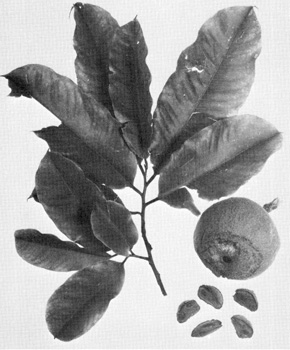|
Common names: coyo, coyo avocado (English); coyo, coyocte, shucte, chucte (Spanish); avocatier du Guatemala (French). Origin: Mexico. Central America. Distribution: Tropical America. Cultural requirements: Cool tropical to subtropical climate. Good soil drainage essential. Description: Tree to 25 m. Propagation by seed, grafting. Flowers February-April (Central America). Fruit matures in 100-120 days. Fruit pyriform, 5-10 cm in diameter, 150-900 g, solitary; external color green, internal yellow. Utilization: Pulp eaten fresh. Flavor rich, nutty. Good source of oil. minerals. Pulp often fibrous. Little potential outside native area because not as pro-ductive as avocado. Reference: Popenoe 1939. LecythidaceaeBertholletia excelsa Humb. et Bonpl.Common names: Brazil nut (English); nuez del Brazil (Spanish); amande d'Amérique, noix de Brésil (French); castanha do moranhao (Portuguese). Origin: South America. Distribution: South America; introduced elsewhere but rare. Cultural requirements: Hot, humid tropical lowlands with deep, fertile soil. Description: Tree to 45 m. Propagation by seed. Fruit production in 8-12 years. Fruit spherical to ovoid, 10-15 cm in diameter; external color brown, edible portion white. Utilization: Seed eaten fresh, roasted. Flavor rich, excellent; general appeal. Important commercial crop, limited possibility for expansion References: Fouqué 1974, Leon 1968. Grias cauliflora L. Common names: anchovy pear (English); paco, pera de anchoa (Spanish); poire d'anchois (French). Origin: West Indies, Colombia. Distribution: West Indies, South America. Cultural requirements: Hot, humid tropical lowlands; swampy areas. Description: Tree to 15 m. Propagation by seed. Fruit pyriform, 5-8 cm long; external color brown. Utilization: Pulp eaten fresh. Little potential for development. Reference: Fouqué 1974. |

Figure 21. Brazil nut, one of the best tropical nuts. Lecythis elliptica Kunth Common names: monkey pot (English); olla de mono, sapucaia (Spanish); marmite de singe (French). Origin: South America. Distribution: Introduced elsewhere into Tropics but rare. Cultural requirements: Hot, humid tropical lowlands; deep, fertile soils best. Description: Small tree. Propagation by seed. Fruit 9 cm long, 7.5 cm in diameter; external color brown, edible portion white. Utilization: Seed eaten fresh, roasted. Flavor excel-lent; high appeal. Rich in oil, protein, B vitamins. Good potential for development as commercial crop. References: Fouqué 1974, Leon 1968. Lecythis ollaria L. Common names: monkey pot (English); olla de mono (Spanish); noix de sapucaia (French); cambuça de macao, sapucaia (Portuguese). Origin: Brazil. Distribution: South America; introduced elsewhere but not common. |